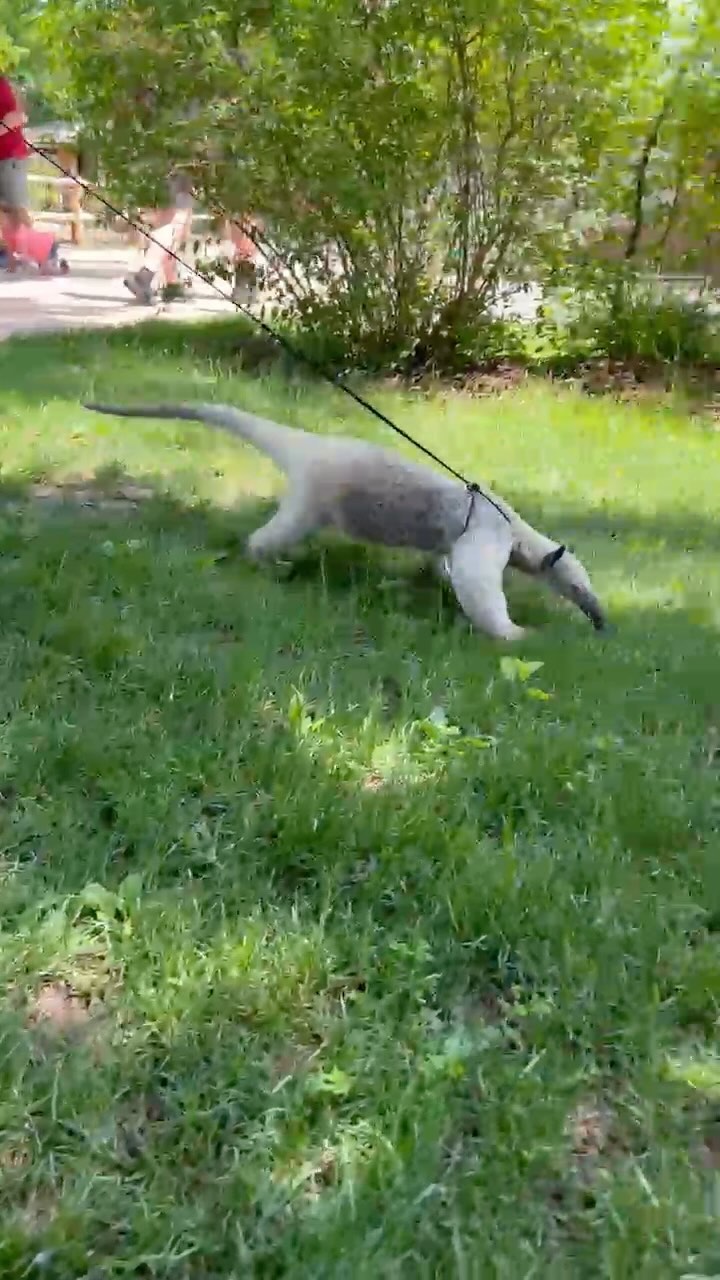- Enrichment significance for ambassador animals
- The role of physical exercise in animal welfare
- Tailoring enrichment activities to specific species behaviors
- Insights into the natural behavior of Southern Tamanduas
- How animal keepers like Nicolette, contribute to conservation efforts
Ambassador animals are crucial in raising awareness and fostering an appreciation for wildlife conservation. To maintain their physical and mental well-being, they receive a variety of enrichment activities, and today, we highlight a notable example: a Southern Tamandua named Olive taking a stroll. Regular walks are an opportunity for Olive to explore and exhibit natural behaviors and serve as public engagement and educational platforms.
Firstly, enrichment is a fundamental aspect of modern animal care practices. It involves providing stimuli that encourage natural behaviors, contribute to an animal’s overall well-being, and reduce stress. Environments can be enriched in numerous ways, including introducing novel foods, sensory stimuli, cognitive challenges, and opportunities for social interaction. Each species has distinct needs, thus activities like the Southern Tamandua’s exploratory walks are integral to their enrichment repertoire.
Physical activity is a key component of animal enrichment, especially for species that traverse large distances in the wild. Exercise is vital for maintaining muscle tone, cardiovascular health, and joint flexibility. In the case of Olive the Tamandua, walking simulates foraging journeys they would partake in their natural habitat. These activities align with their instinctual propensity for movement, facilitating a form of physical enrichment that is both engaging and beneficial to their health.
Customizing enrichment to the natural behaviors of each species is critical. For Southern Tamanduas, whose lives in native South American forests involve climbing trees and hunting insects, providing opportunities to climb, dig, and forage is essential. An enrichment program designed around these activities encourages physical activity and mental stimulation. It’s a stimulating scenario that mirrors the diversity and unpredictability of their natural environment.
Understanding the behaviors of Southern Tamanduas is instrumental to their enrichment. These arboreal creatures are adapted to a life spent predominantly in trees, equipped with sharp claws for climbing and an elongated snout for consuming ants and termites. Therefore, enrichment should incorporate elements of climbing and foraging to trigger these species-specific behaviors. Factors like the terrain, the material provided for digging, or how scent trails are laid out can significantly influence the animal’s engagement and satisfaction levels during these walks.
Animal keepers, such as Nicolette, from our example, are at the forefront of these conservation efforts. Their insights into animal behavior and welfare needs are indispensable in crafting effective enrichment programs. Keepers form bonds with the animals they care for and can finely gauge the right stimuli for each individual. The health and happiness of animals like Olive the Tamandua reflect the daily dedicated work these professionals do.
Additionally, the ambassador animals’ role extends to educating the public about species conservation. As visitors observe Olive on her walk, they connect with a piece of the natural world that is often distant from their daily lives. This form of dynamic conservation education highlights species’ natural behaviors and conservation status, fostering a deeper understanding and appreciation in the audience. This connection can inspire visitors to support conservation initiatives and become more environmentally responsible in their own lives.
In conclusion, structured enrichment like “Let’s go for a walk!” is a practice deeply rooted in a scientific understanding of animal behavior and welfare. It addresses the physical and psychological needs of ambassador animals while simultaneously engaging the public in conservation education. The role of keepers such as Nicolette in applying their extensive knowledge and dedication to these animals’ well-being is invaluable. As we look closer at the lives of creatures like Olive the Southern Tamandua, we learn about the needs of these fascinating animals and gain insight into the harmonious potential between humans and the natural world.
*****
Source Description
Let’s go for a walk!
Ambassador animals get enrichment in different ways. Today, our southern tamandua, Olive, is taking a walk! Other times, she might get an unusual food or a puzzle feeder, or space to dig for bugs. Enrichment is tailored to each animal’s natural behavior and needs.
Thanks to Keeper Nicolette for sharing!
class=”instagram-media” data-instgrm-permalink=”https://www.instagram.com/reel/C7ReFkysnim/” data-instgrm-version=”14″ style=” background: border:0; border-radius:3px; box-shadow:0 0 1px 0 rgba(0,0,0,0.5),0 1px 10px 0 rgba(0,0,0,0.15); margin: 1px; max-width:540px; min-width:326px; padding:0; width:99.375%; width:-webkit-calc(100% – 2px); width:calc(100% – 2px);”>


